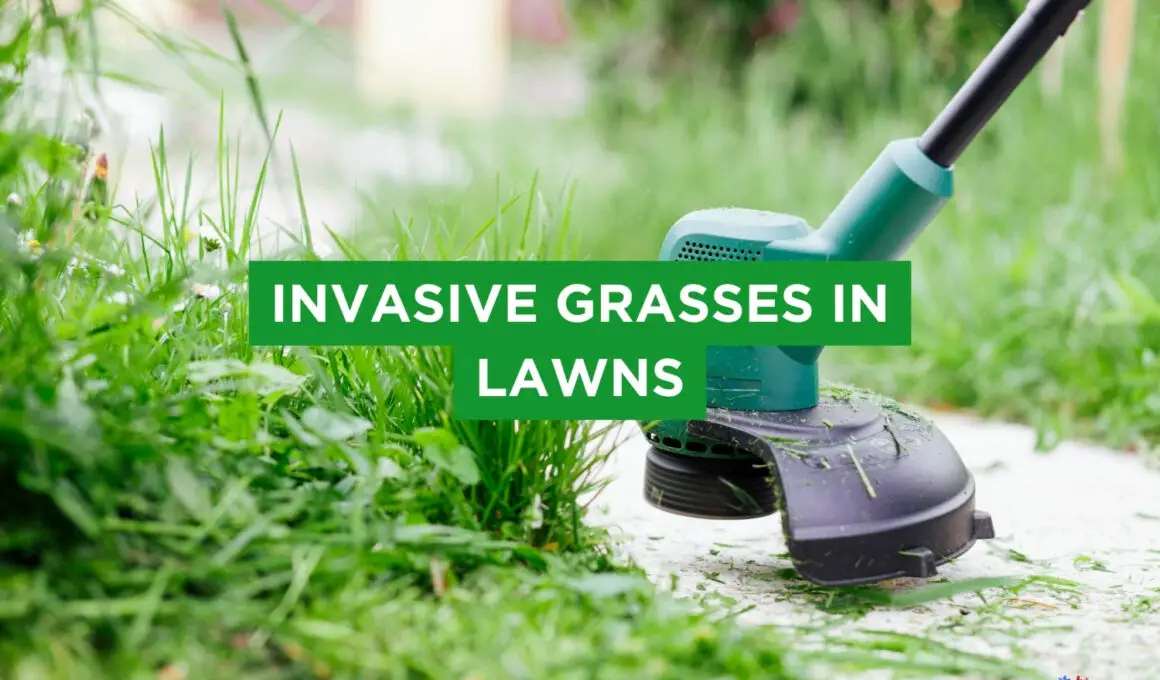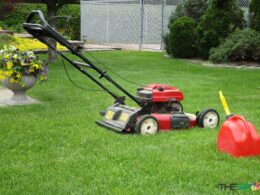In This Article Show
This is the comprehensive guide that every lawn lover and homeowner will find invaluable – a complete exploration of invasive grasses in lawns. As an experienced lawn care expert with over a decade of hands-on experience, I’ve seen firsthand the havoc that these unwelcome visitors can wreak on a beautiful lawn.
So, what are these uninvited guests we are referring to? They’re invasive grass species, plants that, once they find their way into your lawn, can take over and choke out your preferred grass, turning your lush, green oasis into their territory.
But don’t worry, recognizing and dealing with invasive grasses is a lot simpler than it sounds, especially if you have the right information.
From my 13 years of experience in the field, I’ve gleaned practical knowledge and effective techniques that I will share with you throughout this blog post. We’ll go through the nitty-gritty of identifying these grasses, understanding the damage they can cause, and most importantly, effective prevention and control measures.
Whether you are a seasoned lawn caretaker or a novice starting your journey, this guide is crafted to assist you. We’ll keep it straightforward, professional, and most importantly, easy to understand.
What Are Invasive Grasses?

Before we dive into the list of culprits invading our beautiful lawns, it’s crucial to understand exactly what we’re dealing with. Invasive grasses are non-native species that have been introduced into an area, whether intentionally or not.
Get Gardening For Beginners
Our new EBOOK shows newcomers and green thumbs alike a step by step guide to growing the garden of their dreams.
Unlike the well-behaved native grasses that coexist on your lawn, these invasive species play by their own rules. Their aggressive growth and ability to adapt give them an upper hand, often leading them to out-compete and displace the native species.
From my professional perspective of 13 years in lawn care, I can attest that these grasses are an increasingly common problem. They can quickly transform a well-manicured lawn into a wild, unruly meadow if not kept in check. Their seeds can easily hitch a ride on shoes, clothes, or even the wind, meaning they can infiltrate your lawn without your knowledge.
But it’s not all doom and gloom. Knowing what to look out for and how to deal with invasive grasses can make a world of difference. In the following sections, we’ll delve into identifying these intrusive grass species, their impacts, and most importantly, how to control their spread effectively.
The Impact of Invasive Grasses
One might wonder, “What’s the big deal about a few different types of grass growing on the lawn?” The concern isn’t about variety; it’s about the disruptiveness of these particular species. Invasive grasses can cause various types of damage that go beyond simple aesthetics.
Firstly, invasive grasses are ecosystem disruptors. They out-compete native plants for resources such as light, nutrients, and water. In doing so, they can displace local fauna that rely on native plants for food and habitat, creating a ripple effect throughout the ecosystem.
Secondly, invasive grasses can significantly impact the health and appearance of your lawn. They often grow faster, spread quickly, and can tolerate conditions that your chosen lawn grass may not. This means they can create uneven, patchy lawns and, in some cases, take over entirely.
Lastly, from an economic standpoint, managing and eradicating invasive grasses can be costly and time-consuming. They can reduce property values due to their impact on the lawn’s aesthetics and the perceived maintenance costs by potential buyers.
Get Gardening For Beginners
Our new EBOOK shows newcomers and green thumbs alike a step by step guide to growing the garden of their dreams.
In short, the impact of invasive grasses on our lawns and local ecosystems is significant and far-reaching. Identifying and managing these intruders promptly is crucial to maintaining a healthy lawn and a balanced local environment.
Identifying Invasive Grasses
Understanding what you’re up against is the first step to regaining control of your lawn. Below is a list of common invasive grasses that could be lurking in your lawn, complete with their descriptions and identifying features.
1. Crabgrass (Digitaria)

Known for its low-growing, sprawling habit, crabgrass spreads quickly and can dominate a lawn if not managed. Its coarse texture and lighter green color make it easy to spot against a backdrop of desired turf grasses.
2. Bermuda Grass (Cynodon dactylon)
Often considered lawn grass in certain climates, Bermuda grass can quickly become invasive in others. Its fast-spreading nature, via both seeds and an extensive root system, enables it to quickly take over lawns.
3. Quackgrass (Elymus repens)
Distinguished by its long, tapered blades and distinctive, spiraling seed head, quackgrass is a persistent invader due to its deep, spreading rhizomes.
4. Dallisgrass (Paspalum dilatatum)
Easily identified by its coarse texture and prominent seed heads, Dallisgrass thrives in warm, moist conditions, making it a common sight in southern lawns.
5. Nutsedge (Cyperus species)
Though technically a sedge and not a grass, Nutsedge is a common lawn invader. It can be identified by its triangular stems and the distinctive clusters of nutlets at its roots.
6. Tall Fescue (Festuca arundinacea)
This grass has a clumpy growth pattern, and its coarse texture can disrupt the smooth appearance of a lawn. Its deep green color can also contrast with other grass species.
7. Zoysia Grass (Zoysia spp.)
While it can make a great lawn when wanted, it can be very invasive in areas where it’s not desired. Its dense, mat-like growth habit can choke out other grasses and plants.
8. Ryegrass (Lolium spp.)
Known for its rapid growth rate, ryegrass can become invasive quickly. Its deep green, shiny leaves and the ability to thrive in many conditions make it an unwelcome guest in lawns intended for other grass species.
9. Foxtail (Setaria spp.):
Easily identified by its distinctive, bushy seed head that resembles a fox’s tail, foxtail is an annual grass that thrives in disturbed soils and can quickly infest lawns.
10. Goosegrass (Eleusine indica)
Similar to crabgrass but even more resilient, Goosegrass is characterized by its prostrate growth habit and finger-like seed heads. It thrives in compacted, poorly-drained soils.
11. Pampas Grass (Cortaderia selloana)
While often planted intentionally for its tall, attractive plumes, Pampas Grass can spread aggressively and become difficult to remove due to its deep roots.
12. Johnson Grass (Sorghum halepense)
This perennial weed grows in clumps and can reach heights of up to six feet. It is particularly invasive due to its underground rhizomes and high seed production.
These are just a few invasive grass species you might encounter on your lawn. However, knowing what to look for can help you catch any infestation early and keep your lawn looking its best.
Each of these grasses has its strategies for out-competing your chosen lawn grass. However, armed with this knowledge, you can watch for these invaders and act promptly at the first sign of trouble.
Preventing the Growth of Invasive Grasses
Prevention, as the saying goes, is indeed better than cure. And this axiom holds when dealing with invasive grasses. Implementing the right preventative measures can save you time, money, and a lot of frustration in the future. Drawing on my extensive experience of over 13 years in the field, here are some best practices to keep your lawn free from invasive grasses.
1. Proper Lawn Maintenance:
A healthy lawn is your best defense against invasive grasses. Regular mowing, watering, and fertilizing will help your preferred grass species thrive and out-compete any potential invaders.
2. Understanding Soil Health
Soil quality plays a pivotal role in the health of your lawn. Ensuring your lawn’s soil is well-drained and nutrient-rich will help your grass grow stronger and resist the invasion of undesirable grass species.
3. Regular Inspection
Stay vigilant. Regularly inspect your lawn for signs of invasive grasses, particularly in high-traffic and border areas where they’re most likely to appear. Early detection and action can save you from a much bigger problem down the line.
4. Reseeding Bare Patches
Bare spots in your lawn can act like an open invitation to invasive grasses. By promptly reseeding these areas, you reduce the chance for invaders to take hold.
Remember, a little bit of prevention can go a long way. By following these steps, you’ll be well on your way to maintaining a lush, healthy lawn free from invasive grasses.
Controlling and Managing Invasive Grasses
Despite your best preventive efforts, you may still find invasive grasses on your lawn. Don’t despair; several methods exist to control and manage these unwelcome guests effectively.
1. Herbicides
These can be a powerful tool in the fight against invasive grasses. Pre-emergent herbicides can prevent the growth of invasive grass seeds, while post-emergent ones can help control grasses that have already sprouted. Remember to use these carefully, as they can also harm desired plants.
2. Organic and Natural Methods
There are several options for those who prefer a more eco-friendly approach. Hand pulling, though labor-intensive, can be effective for small infestations. Solarization, a process where you cover the infested area with a clear plastic sheet to trap the sun’s heat, can kill both the grass and its seeds.
Another method is using a vinegar solution or other natural herbicides, which can be effective against young invasive grasses.
3. Introducing Competitive Species
Planting species that can compete with invasive grasses for resources can also be an effective control method. Select native plants or grasses that can thrive in your lawn’s conditions to help crowd out potential invaders.
While managing invasive grasses can seem daunting, remember that it is a process. With patience, persistence, and the right strategies, you can regain control of your lawn and maintain its health and beauty for years to come.
Wrapping it up
Navigating the world of invasive grasses can seem overwhelming. But with knowledge and proactive measures, you can protect your lawn from these unwelcome intruders and maintain its health and beauty.
Whether you’re identifying different types of invasive grasses or learning about prevention and management techniques, remember that the health of your lawn is a journey, not a destination.
Leveraging my 13 years of experience in lawn care, I’ve shared insights and best practices with you to help you combat invasive grass species. While challenges may arise, know that every step taken towards maintaining and caring for your lawn is a step towards a more beautiful and enjoyable outdoor space.










